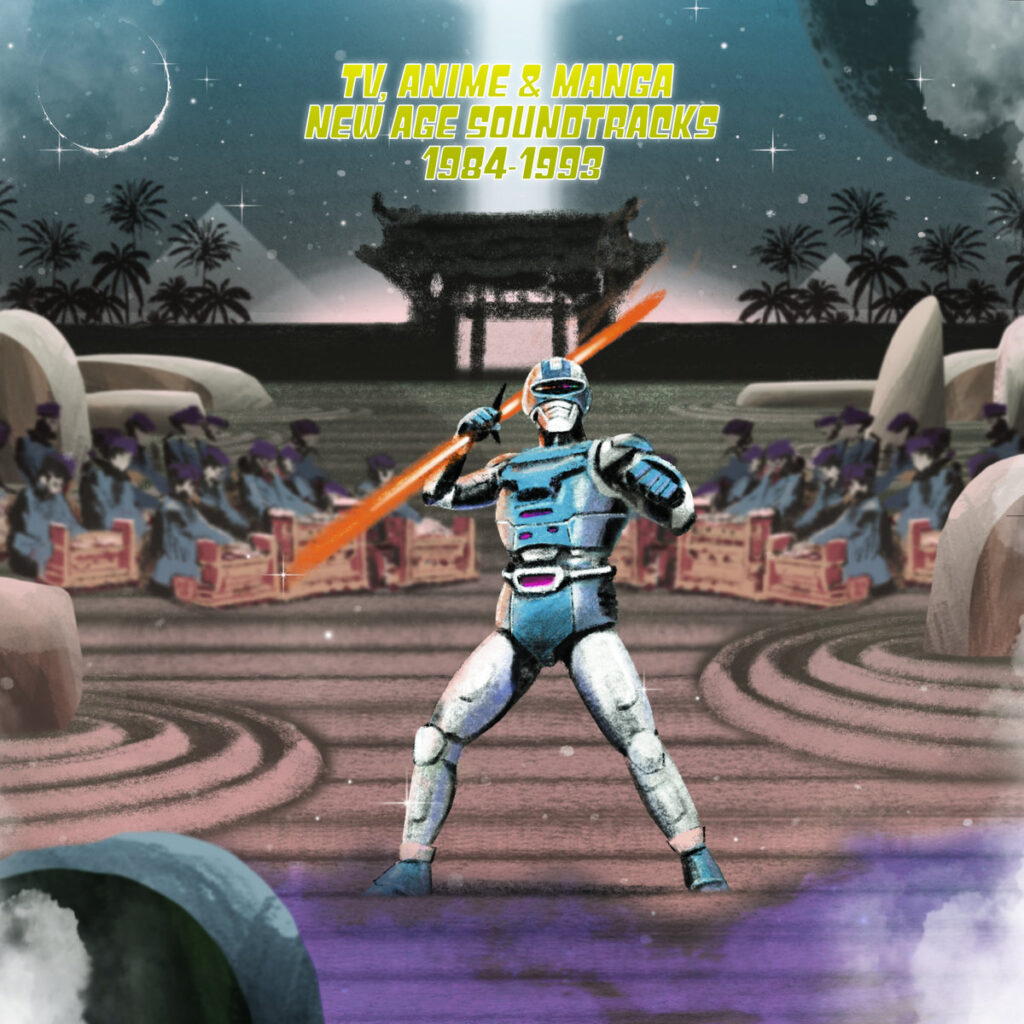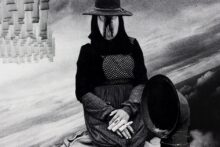“Kanedaaaaaa!”
One of the most iconic anime films ever also had one of the most iconic soundtracks. Akira’s gamelan percussions (represented on this comp by the ‘Kaneda’ theme) were made by massive Japanese side-hustle group Geinoh Yamashirogumi, led by the scientist and composer Shouji Yamashiro (a pseudonym of Tsutomu Ōhashi). He formed the group in the 1970s from a cast of hundreds of people with other jobs. They began with a string of choral albums – Romanian polyphony, early music etc. – before switching lanes dramatically with a disco funk album. Then, in the 80s, began to draw on traditional percussion music, first from a variety of regions across the African continent, then Balinese gamelan for Symphonic Suite Akira in 1988.
That gamelan sound is the cue for this compilation, TV, Anime & Manga New Age Soundtracks 1984-1993, a follow up to Anime & Manga Synth Pop Soundtracks 1984-1990 on Time Capsule, a label run by Japanese DJ and producer Kay Suzuki out of London, which is connected to the venue Brilliant Corners and the clubnight Beauty and the Beat. It traces Akira‘s gamelan to the influence of percussionist and composer Yas-Kaz, who trained as a jazz and avant-garde musician before heading off to Bali to study gamelan in the mid 70s, returning to Japan with this knowledge and then incorporating it into his new age music, which then filtered out into anime and TV. He introduced Midori Takada and his future collaborator Ryuichi Sakamoto to gamelan, as well as Shouji Yamashiro.
The title might throw manga and anime fans – the collection here pulls from across globally iconic phenomenon (Akira) and deeper cuts (Peacock King) as well as music made as franchise expansions to printed media, and then there’s the TV music thrown in too (which is admittedly some of the stronger material). It contains just eight tracks, which makes it feel like the premise – to draw out how that gamelan ended up in Akira – hasn’t quite held up (as with the extremely vague exotica influence on ‘Theme For Andrew Glesgow’).
What is most interesting are the tangents here: the musical routes taken by the composers; the groups they connected with or came from, and the lineage of the imported Balinese forms and other traditional instruments. There is a particularly strong link to butoh via the legendary Sankai Juku troupe, whose epic performances in white body paint involve eggs, strikingly minimal costumes, and entire sets flooded with water or filled with sand. Yas-Kaz composed for them, and Yoshiro Yoshikawa came out of that group into music, too. He became obsessed with electronic instruments and ended up riding the wave of fourth world music that had begun with Brian Eno and Jon Hassell‘s eponymous album, and became a genre unto itself. Yas-Kaz’s ‘Hei (Theme of Shikoni)’, here is standout, led by a shawm over multitracked hand drums, made for one of the Peacock King anime TV series and its heavily psychedelic Buddhist iconography. Yoshikawa also has two of the strongest tracks on the comp in ‘Tassili N’Ajjer’, which includes tabla, a bendy string line over pleasingly warped synth stabs, and ‘Fiesta Del Fuego’. Both are a glossy take on fourth world, composed for an NHK nature show called The Miracle Planet. ‘Fiesta del Fuego’ uses the familiar sound of the Kecak or Ramayana monkey chant (which also appears in Akira), which is itself an art form that, while now considered an important Balinese art form, has it roots entangled in mainstream Western culture.
The chant was devised in the 1930s by Russian born German-American choreographer Walter Spies (who was expert in Balinese music and had directed the Sultan’s orchestra in Java) for Baron Victor von Plessen’s Hollywood epic The Island Of Demons. Spies borrowed ancient Balinese exorcist chants called sanghjang and built a choir of 100 men who sang the piece without accompaniment around a flaming tree, to represent the part of an army of monkeys who save Prince Rama from the demon King Ravana. British field recordist David Lewiston then recorded it in Bali in 1969 – admitting in the notes it was a 20th century creation that nonetheless had roots further back in the exorcism chants that were its source material – and it was released by Nonesuch on its iconic Explorer series. Since then it has cropped up in a vast array of music and film soundtracks – in Fellini’s Satyricon; the Coen Brother’s Blood Simple; Pasolini’s Oedipus Rex, and in the music of Yellow Magic Orchestra, Devo, and Nurse With Wound, to name just a few.
There are a few weak links in the playlist. I dislike the cheese of Chumei Watanabe’s ‘Fushigi Song’ in particular, from the theme for the villain’s lair in tokosatsu show Space Sheriff Shaider (who graces the cover). The label want to compare it to ‘Brown Rice’ but that’s a bit of a stretch. It’s charming, has a certain groove, but the Don Cherry reference either minimises ‘Brown Rice’ or overly elevates this music, which feels bulbous and gummy alongside the synthetic shimmer of other tracks. Violinist and composer Norihiro Tsuru’s ‘Farsighted Person’ is much better, from the soundtrack to the anime The Heroic Legend of Arslān, set in Iran, conjuring a vague sort of Near East mood music as a bed for his violin. Music made as satellites and side releases for printed material include ‘Gishin Anki’ by Kan Ogasawara (taken from a CD produced to accompany a 20 volume manga series called Yumi No Ishibumi) and ‘Theme For Andrew Glesgow’ from a manga series called Palm – The Sea Shouldn’t Exist, the latter’s percussions only very vaguely holding to the compilation’s conceit, and led by a mediocre saxophone.
TV, Anime & Manga New Age Soundtracks 1984-1993 seems designed to catch the backwash from the wave of Western interest in Japanese ambient and citypop that’s emerged in the last five or so years, following the huge success of some key compilations like Light In The Attic’s Kankyō Ongaku, and reissues of composers like Hiroshi Yoshimura. Often, this music was created for a mainstream audience and was on major labels, some of it selling in huge numbers, but as an export to Westerners it is often pitched as rarified or interesting, and even experimental. This mode of (re)sale for consumption now occasionally has an orientalist texture: its foreignness to English speakers is often what seems to place it in the racks. This compilation adds another layer of complexity to this exchange, where the Japanese composers imported musical traditions otherwise foreign to them, in ways that in some cases are lazy or appropriative, but in others involve sensitivity alongside formal tuition. Notably, the (dual-language) sleevenotes by Anton Spice and label head Kay Suzuki do not ignore this difficulty, recognising that there’s a possible reading of this music that amounts to “a neo-colonial flattening of cultural specificities, appropriated for aesthetic or profit”, although, in collecting and releasing this music on vinyl it’s hard to see how the compilation is offering a corrective.
It may be that the overly-definitive title is tripping me up, as given the amount of new age and ambient, anima and manga was being pumped out in these periods, the single LP format with just eight tracks on feels limited, and might have been better served by something less concrete and completist sounding (I’m thinking of Efficient Space’s Ghost Riders). What’s most interesting about this compilation is also what’s most complicated: the way exposure to traditional forms of music foreign to these Japanese composers led to them developing synthetic, future-seeking soundtracks that lifted these traditional forms, edging high-fidelity electronic soundtracks into new styles – whether through overseas study (as with Yas-Kaz) or by armchair renderings of the exotic and foreign – that could articulate the imaginary landscapes of these animated worlds.
Thanks to Jaimie Sutcliffe for extra reporting. TV, Anime & Manga… is out today via Time Capsule






